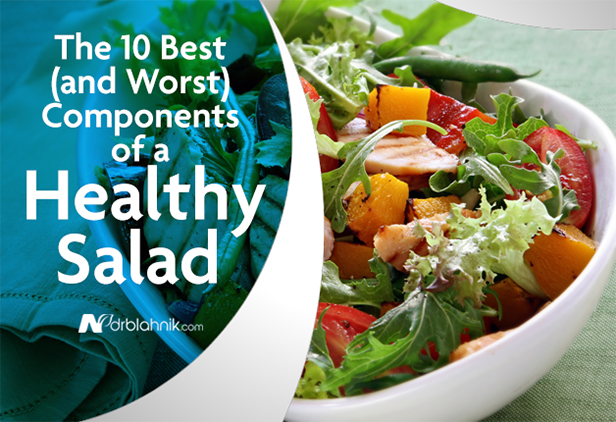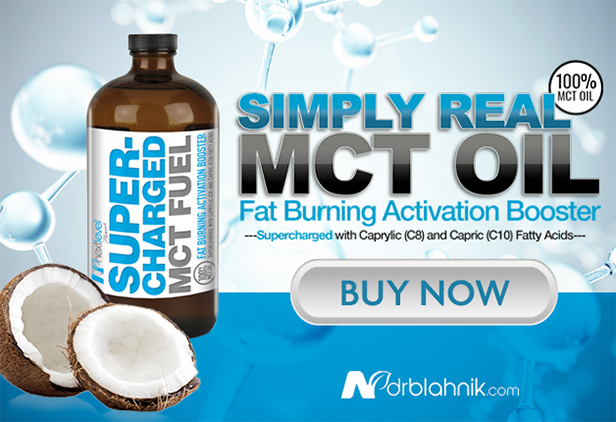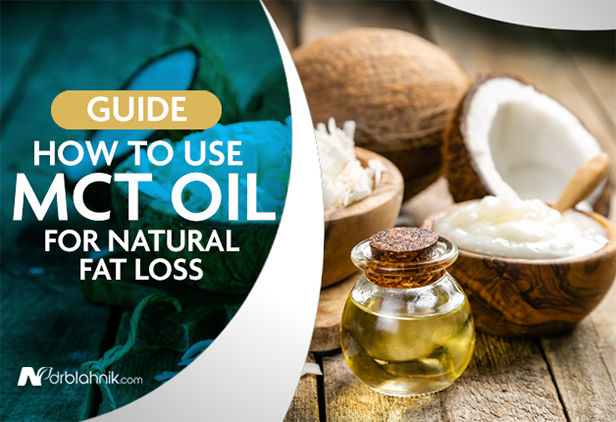A salad is a great way to enjoy a meal, ensuring that you get the necessary vegetables and vitamins you need to keep your body healthy. When you think of a salad, we are certain you can name several of your favorite types that you indulge in when you want a less taxing meal. What you might not know is that salads are a much more complicated meal than you might imagine.
While you might imagine that your favorite salads are immutably healthy, some salads lose their nutritional value through additions that favor flavor over health. Several components of a salad are extremely good for you and even more that are notoriously bad for you. We hope to help you better understand which components are best to make the healthiest possible salad without losing out on flavor.
Table of Contents
The 10 Best Ingredients for Your Salad
Salads are not just a mixture of lettuce to be flavored with dressing, but can also incorporate several other vegetables and legumes to help increase the flavor and nutritional benefits of the finished meal. Not all these ingredients will be enjoyable for every consumer but might help aid you in your endeavor to make new salads:
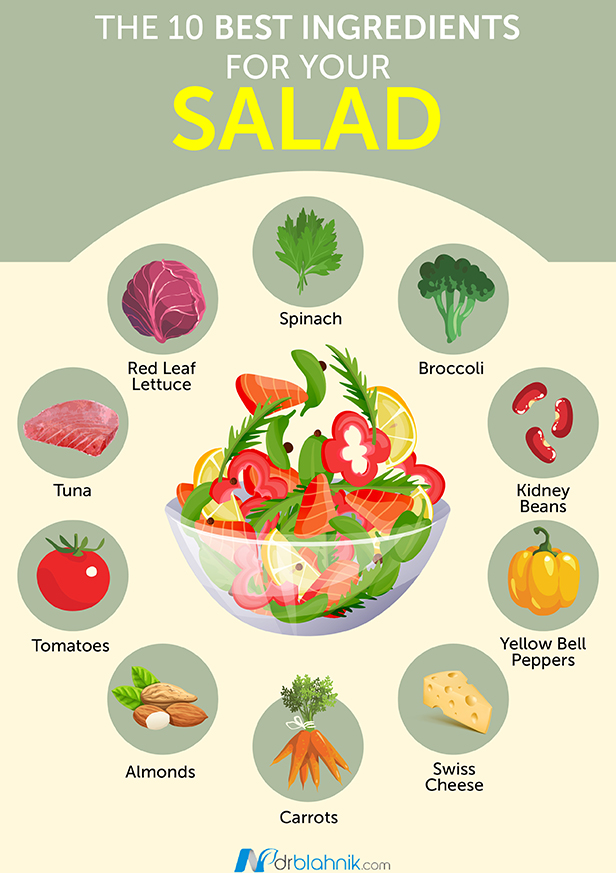
1. Spinach: Spinach is more than just the vegetable of choice for our nautical friend Popeye. It has all sorts of health benefits associated with its consumption due to being packed with nutrients, vitamins, and all sorts of other organic matter that help our bodies. A single cup of spinach provides 58 mg of folate, which, according to Nutrition Digest, provides a 12% decrease in your chances of suffering a heart attack. Spinach also provides copious amounts of fiber, protein, vitamins A, B6, C, E, and K, calcium, and potassium. All of which are crucial nutrients to the human body. Spinach also adds a lovely boost to our ability to fight off diseases like Alzheimer’s, cancer, osteoporosis, diabetes, depression, and obesity.
2. Broccoli: That time-tested vegetable that was the bane of all of us at the dinner table in our youths, it turns out that mom was not lying when she said broccoli is good for us. Three florets of this tree-looking vegetable will provide you with a whopping 294 mg of potassium. The benefit of this concentration of potassium is that, according to the Mayo Clinic, it counteracts sodium concentrations to help you lower your blood pressure and reduce the odds of you suffering from a stroke. Broccoli also provides calcium, fiber, folate, lutein, zeaxanthin, and vitamins A, B6, C, and K.
3. Kidney Beans: Kidney beans, so named for their reddish coloration and peculiarly kidney-like shape, are as healthy as they come. A ¼ cup of kidney beans packs three grams of fiber plus thousands of antioxidants and will grant your salad a massive amount of nutrients and a notable amount of protein and folate.
4. Yellow Bell Peppers: Yellow bell peppers are not just ideal because they are bright and happy, but because they add a lovely tang, and four strips come to the party with 48 mg vitamin C, which is great for fighting off free radicals. On top of that, yellow bell peppers provide vitamins A and B6, folate, and potassium.
5. Swiss Cheese: If you thought only vegetables were great and healthy additions to salads, you thought wrong. While not exactly great in excess, Swiss cheese can be a healthy treat to toss into your salad as a topping occasionally. Since cheese is dairy, spoiler alert, it comes with many benefits you would see in other dairy products like calcium. Four cubes of Swiss cheese provide 476 mg of calcium to help reinforce your bones. Swiss cheese also produces protein and vitamins D and B12.
6. Carrots: You might have heard the adage about carrots being good for your eyes. Well, the truth is that carrots are packed to the brim with provitamin A carotenoids that also serve as antioxidants. A ¼ cup of shredded carrots will load you up with 2,279 mcg of beta-carotene as well, making carrots one of the more nutritious additions to your salad while also giving it a satisfying crunch. Carrots will also add vitamins C and K, fiber, and potassium to your salad, while vitamin A gives your salad the vision-boosting this orange vegetable is known for.
7. Almonds: Adding nuts to your salad might seem… well… nuts. However, almonds are an extremely beneficial example of how nuts can make your salad healthier, more nutritious, and more filling than it might otherwise be. A single tablespoon of almonds provides 2.2 grams of alpha-tocopherol, a variant of the more common vitamin E. Additional nutritional benefits of almonds include protein, fiber, and monosaturated fat.
8. Tomatoes: Tomatoes are a brightly colored, juicy, and very tasty fruit commonly used in salads, among other foods. When it comes to health and nutrition, four cherry tomatoes provide 1,748 mg of lycopene, which is known to fight off cancer cells. It also brings vitamins A, C, and K, fiber, and potassium to the table.
9. Tuna: Probably the fishiest ingredient you will find on this list, the use of tuna in salads is not as uncommon as you might otherwise believe. For one thing, tuna is an amazing source of protein. It also has no trans fats and contains niacin, which bolsters cardiovascular health. According to the University of Rochester, niacin also increases your high-density lipoprotein concentration, improving your cholesterol. Tuna also provides vitamin B12.
10. Red-Leaf Lettuce: Red-leaf lettuce might seem like your ordinary lettuce used in a salad if you disregard the color, but it does come with an array of nutrients that are extremely good for you. Four leaves of this alternately colored lettuce provide 1,213 mcg of antioxidants, 96 mcg of vitamin K, and 1,172 mcg of lutein and zeaxanthin. Red-leaf lettuce also provides vitamins A, B6, and C, folate, and potassium.
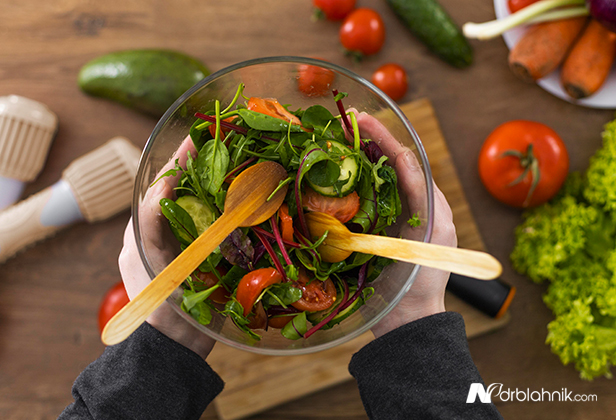
These ingredients are only some of the healthy options you can add to your salad to fine-tune it for your tastes and health needs. If you follow a vegan lifestyle, not all of these ingredients will be ideal for you. Many of them are still viable vegan options for getting those essential nutrients that might be more difficult to consume if you live off salads and other vegetable-based meals.
The 10 Worst Ingredients for Your Salad
While finding viable and healthy additions to your salad might be difficult, it is much easier to eliminate unhealthy ingredients in your salad. In theory. In practice, you might find yourself frustrated at the notion of having to remove some of your favorite salad toppings and ingredients.
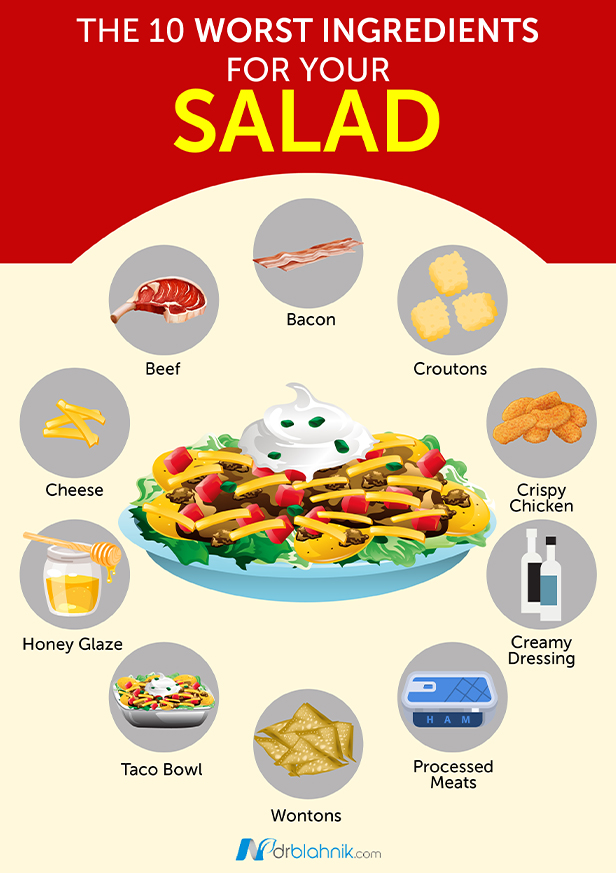
1. Bacon: One of the most popular foods in the country, you can find bacon in almost everything nowadays, including questionable treats such as bacon brownies and cookies. However, if you intend to use it for a salad topping, you might want to think twice. Bacon is a highly fatty cut of meat, adding 30 grams per strip at a minimum as well as jacking your cholesterol up by a substantial amount.
2. Croutons: Re-fried bread that has been traditionally sprinkled onto salads with reckless abandon for some time, croutons are as unhealthy as they are tasty. Bread in and of itself is a rather substantial source of carbohydrates and starch that will calorically devastate your salad without any real nutritional value.
3. Crispy Chicken: That was a lie… sort of. Crispy chicken, being a heavily fried addition of protein to your salad, is bad for your otherwise healthy salad. However, the same principle applies to anything crispy you might seek to top your salad. The oils used to fry your crispy treat jack up the trans fat content of the food beneath the exterior, even if it was once a healthy addition to your salad. If you want chicken, go with a healthily grilled version instead.
4. Creamy Dressing: Picture it. You have just finished mixing an impressive salad packed with vegetables, nuts, and other healthy ingredients. It is beautiful, green, and tasty, but you decide to drown the healthy dish in your favorite dressing. With that single pour, you have tarnished the nutritional value of your salad. The most popular salad dressings are packed with fat and calories that are horrible for you.
-
- Ranch: Easily among the most popular dressings to ever enter the culinary realm, ranch dressing can be packed with 14 grams of fat in a single tablespoon.
- Blue Cheese: Cheese-based and very fatty, blue cheese dressing will add 15 grams of fat per serving added to your salad.
- Thousand Island: A tangy dressing that sees use in many salads and sandwiches; thousand island dressing is no less guilty of fattening up your salad by adding 11 grams of fat per serving.
And before you go switching to the fat-free dressings from your local grocery store, you should be aware that what they lack in fat, they make up for in sugar. Fat-free dressings are just as liable to devastate the health value of your salad as the fatty ones.
5. Processed Meats: If you are looking to add protein to your salad, you might think that grabbing some of the pastrami or ham from your local deli is a good choice. Think again. Deli meats are very fattening and produce a high sodium concentration that will cancel out the health benefits your salad would otherwise provide.
6. Wontons: Many a salad from Asian cuisine uses deep-fried wontons as their answer to the crouton used in western cuisine. These wontons have become popular even in the United States and find their way onto many salads. If you are considering adding them to yours, you might want to reconsider. As another deep-fried topping, these wontons will add fat and calories to your salad that are better left forgotten overall.
7. Taco Bowl: Though uncommon, some people like to swap out the standard bowl and make themselves a taco salad complete with an edible tortilla bowl. A single taco shell bowl adds 11 grams of fat to your salad. It makes it ridiculously unhealthy by adding all the consequences of the other carbohydrate-based toppings we have listed today.
8. Honey Glaze: Some salads like to add in toppings that have been glazed in honey, such as chicken or peanuts, to add protein, flavor, and crunch. However, though the food that has been coated may once have been a healthy addition, the glaze coats them is sugar and ruins their nutritional value.
9. Cheese: Now we know what you are thinking. “But you just said Swiss cheese is good!” Well, we also made it clear that it was only the case in moderation. Not to mention that Swiss cheese is not commonly applied to salads in the same way American cheddar is. Some cheese adds saturated fats that wreck the healthy balance of a salad if moderation is not exercised.
10. Beef: While beef can be quite common in diets designed to help bolster your health and reduce your fat intake, the beef used in a salad is rarely lean. Usually, salads that factor beef into their ingredients are taco salads and the like, which tend to throw nutrition to the wind to pack flavor through fatty foods. If you want to beef up your salad, investigate lean beef.
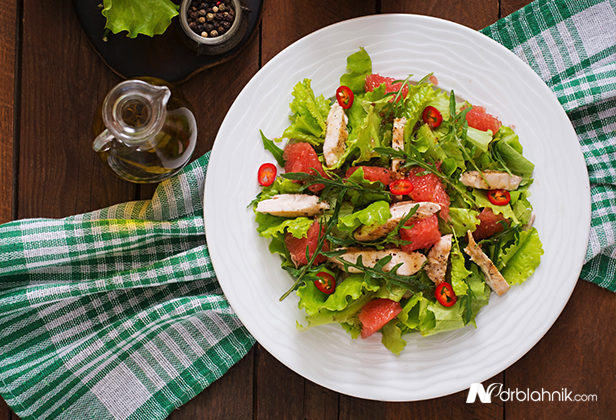
Like the better ingredients we have listed, this list does not encompass every bad thing you can add to a salad. Rather, it produces a guideline of things to avoid and anything like it.
The Point
Salads can be an extremely nutritional alternative for your dinner plans that allow you to eat healthily and reach the best possible version of yourself. However, this can only be achieved if they are properly made and through the ingredients you use. Adding some of your favorite toppings and ingredients might render your salad a fatty abomination that loses its nutritional value for the sake of flavor. However, you can pack your salad with ingredients that provide the taste, texture, and nutrition you might be seeking.
Do you have a favorite topping for your salads? Are they healthy ingredients, or do you believe you may be using unhealthy ingredients instead? After reading this post, are you inspired to use healthier ingredients?

